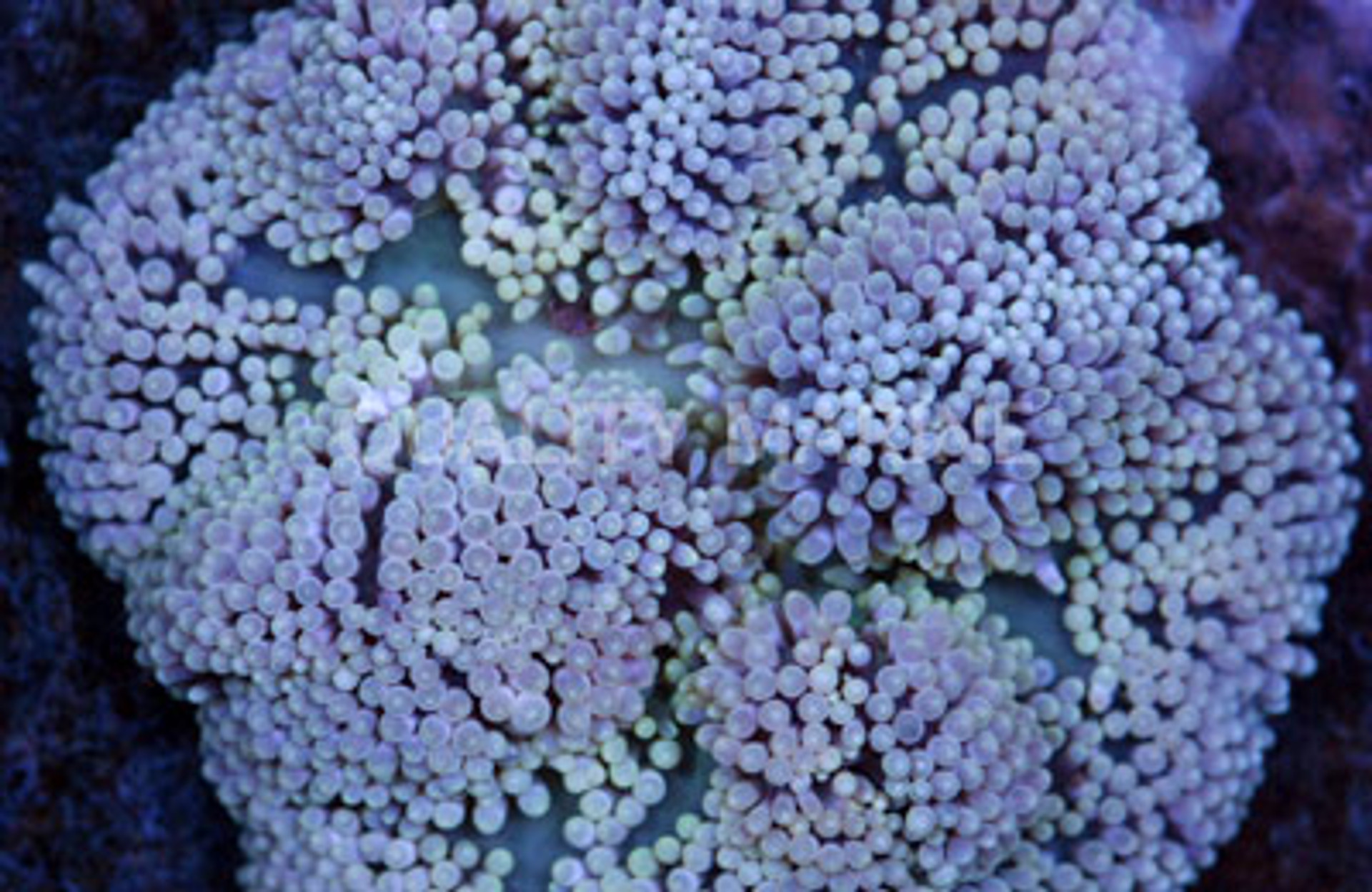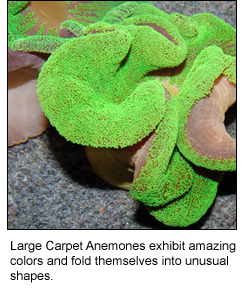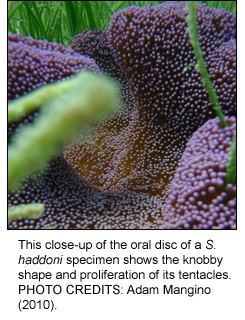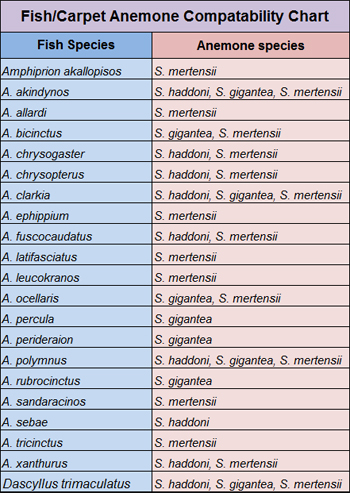The Ultimate Test - Large Carpet Anemones

Scientific Name: Stichodactyla gigantean, S. haddoni, S. mertensii, S. helianthus
Common Name(s): Carpet Anemones
Taxonomy:
Domain: Eukarya
Kingdom: Animalia
Phylum: Cnidaria
Class: Anthozoa
Order: Actinaria
Family: Stichodactylidae
Genus: Stichodactyla

Description:
In our Species Spotlights, our goal is often to present animals that are good for all levels of aquarist, or to dispel misconceptions about misunderstood ones. Occasionally, an interesting animal merits discussion, even though it may in fact be very difficult for most aquarists to keep. Carpet anemones (genus Stichodactyla) are one such animal. They are strikingly attractive anemones, but are also notoriously incompatible with just about everything! Only Amphiprion sp. clown fish, Humbug fish (Dascyllus trimaculatus), and Periclemenes sp. anemone shrimps make suitable tankmates for these voracious anemones. Oh, and did I mention, they get really big! The thing you should know about keeping these challenging animals is that you need to be skilled, dedicated, and prepared to go the necessary lengths to keep them happy and healthy. If you can do that and are selective about the individual you buy, you stand a reasonable chance for successand will have a tank which you can be truly proud of.
Carpet anemones are so-called because of their resemblance towards a shaggy throw-rug. They are solitary polyps that can reach several feet in diameter. Their oral disc is usually green to beige or brown, and is covered by short tentacles. The tentacles may be brilliant shades of blue, purple, white, green, red, or brown, and cover the entire area from the edge of the oral disc to the mouth. They may be club-shaped or pointed, and they pack a serious punch. Nematocysts, which are the tentacles stinging cells, are deadly to most other aquarium livestock and have been known to sting humans as well. Nonetheless, fish and other mobile tank inhabitants usually get the worst of it; the tentacles are also sticky and they catch unsuspecting passers-by for a quick meal. Carpet anemones also move around if they do not like the spot they are in, so it is not unusual to come in one morning and find your specimen on the other side of its tank.
Often found on sandy bottoms, many carpet anemones prefer to attach to a rocky surface buried under several inches of sand. They may lay flat against the substrate, or furl up their edges until they form a mound of furrowed folds. When they do so, these anemones look remarkably like the lobes of a human brain.

Natural Habitat and Ecology:
Most carpet anemones of interest in the aquarium trade originate in the Indo-Pacifc region of the ocean. These animals are found as far west as Madagascar and the Red Sea, and as far east as the Islands of the South Pacific and Southern Japan. At least one trade species, the Caribbean carpet anemone (S. helianthus), is Atlantic in origin. This species is most common in the Southern and Eastern Caribbean, as well as the Bahamas. In all oceans, carpets are found in very shallow waters with severe solar radiation levels. They have even been seen to be exposed during low tides, in certain areas.
Though all are zooxanthallate, carpet anemones also need to consume considerable quantities of meat in order to survive. In the wild, any fish or crustacean unfortunate enough to wander too close to the sticky tentacles of a carpet anemone, receives a powerful dose of paralyzing peptide toxin. There is probably no need to tell you what happens next. Though they are also potently toxic to corals as well, wild carpets are typically found inhabiting sandy areas surrounding reefs, rather than on the reef itself. Amazingly, certain species are able to withdraw completely below the surface of the sand if they are disturbed. The exception is Mertens carpet anemone (S. mertensii), which not only does not withdraw easily, it also does not live in sand at all. Instead, its preferred habitat is usually a bare rock that has a great many crevices.
The pharmaceutical and medical research industries have begun to take interest in the toxins created by Stichodactyla sp. anemones, especially S. helianthus. There is evidence in the scientific literature that some of the numerous toxins made by S. helianthus have, at the very least, anti-tumoral properties. That is, studies have demonstrated that rats with tumors live longer when dosed with extracts of carpet anemone toxin. These same extracts are also acknowledged to have anti-parasitic qualities.

Aquarium Care:
The general rule, although there are many willing to test it, is that large carpet anemones should be kept in a tank of their owna specimen tank. This tank must be bigat least 100 gallons, but preferably 125 gallons or more. Large carpet anemones are sizable animals. For example, S. mertensii can grow an oral disc that measures over three feet in diameter. An anemone as large as this may need to be fed more than a teaspoonful of fish everyday in order to survive. As you can imagine, such a heavy feeding regiment dictates that the tank must be well-established and possess strong filtration. You are going to need heavy-duty protein skimming to keep your water quality clean and stable. It is also recommended that the display have a 4 inch to 6 inch sand bed to accommodate the substrate preferences of most carpet anemones. This layer of deep sand in the main tank will also dramatically improve the bioload capacity, making it easier to keep the system clean. Obviously, the tank will also require a large, rock-free area of open sand, upon which your carpet can settle (except S. mertensii).
Like other anemones, carpet anemones require clean, stable water conditions. They do not do well with environmental fluctuations. Keep their water pristine, and be sure to regulate parameters very strictly. Fortunately, the absolute parameters these animals need are commonplace, and standard reef recommendations are applicable here. Equally important in keeping these impressive polyps alive are the selection criteria you use when purchasing one. Be sure that yours has been well-acclimated to its current conditions before trying to move it. That is, it is inadvisable to purchase an animal your fish store has just received. You will want them to hold it for you for several weeks to ensure that it is healthy and eating properly. Do not buy from online retailers unless you can get a detailed photograph of the precise animal you are buying. Look for any signs of bleaching or damaged tissue as well (it should be noted that S. haddoni comes in a pure white morph that is different than a bleached specimen of another varietywhite is fine, bleached is bad). Captive-bred specimens are preferable but may be very difficult to obtain. Also avoid dyed and bleached-out specimens, which are almost certainly doomed to die. Finally, do not try to fragment your carpet anemone. Doing so will almost certainly lead to its death. The occasionally specimen may reproduce through binary fission, but such behavior cannot be induced.
In general, intense lighting and moderately strong flow are required to keep carpet anemones healthy. Carpets need 6,000K to 10,000K light colors, from T5, VHO, or metal halide bulbs. Water flow needs to be diffuse and non-laminar, and should create a turnover rate of 20 to 40 times per hour. Strong lighting will not replace the need to feed the anemone, which will need to be done several times weekly, to daily, depending upon the species. High turnover will help remove the rather copious amount of waste products, as will oversized protein skimming.
There are four different species of large carpet anemone you are apt to run into in the aquarium trade. Though the basic requirements for each species are essentially the same, there are still some differences that should be highlighted as well.


S. giganteanvery large, oral disc over 1m in diameter but very folded; looks furry rather than knobby; tentacles are sticky; requires most intense lighting; needs deep sand but does not retract; narrow column;
S. haddonivery large, oral disc over 1m in diameter but folded; bulbous and sticky tentacles; mouth is obvious; needs 6 to 8 inch deep sand bed; moderate flow; most common trade animal; large column;
S. mertensii very large, oral disc over 1m in diameter and open; tentacles not sticky; only species that comes in white morph; rare in trade; found in deeper water; can host certain clowns; needs daily feeding; attaches to cracks in rocks; small column;
S. helianthuslikely to eat most fish, including clowns; tentacles pack potent sting; Squat Anemone Shrimp and Banded Clinging Crab are symbionts; scientifically interesting; rarely collected for trade.
In summary, carpet anemones are beautiful but very hard to keep. If you can meet their stringent requirements, you will be rewarded with an animal to which you can become quite attached. They are stunning and lively. On the other hand, if you are not supremely confident in your ability to care for one of these amazing creatures, please do not even make the attempt. Since most animals available are wild caught, each one is precious. You should only buy a carpet anemone if absolutely certain it will survive.
Works Cited:
Anonymous. Sun anemone (Stichodactyla helianthus). Marine Species Identification Portal. URL: http://species-identification.org/species.php?spe...
Castaeda, O., et al. Characterization of a potassium channel toxin from the Caribbean sea anemone Stichodactyla helianthus. Toxicon, 33:5. May. 1995. p.p. 603-613.
Fenner, B. Carpet Anemones in Captive Systems. Wet Web Media Online. 2006. URL: http://www.wetwebmedia.com/carpetanemones.htm
ITIS Report. Stichodactyla tapetum. 2002. URL: http://www.itis.gov/servlet/SingleRpt/SingleRpt?s...
Kem, W.R. and B.M. Dunn. Separation and Characterization of Four Different Amino Acid Sequence Variants of a Sea Anemone (Stichodactyla helianthus) Protein Cytolysin. Toxicon, 26:11. May 1988. p.p. 603-613.
Maddox, M. Carpet Anemones: Big, Beautiful, and Deadly. Conscientious Aquarist Magazine, 6:3. 2009. URL: < http://www.wetwebmedia.com/ca/volume_6/volume_6_3...
Mitchell, J.S. Mobility of Stichodactyla gigantea Sea Anemones and Implications for Resident False Clown Anemonefish, Amphiprion ocellaris. Environmental Biology of Fishes, Vol. 66. p.p. 8590. 2003.
Shimek, R. L. Marine Invertebrates. Neptune City : T.F.H Publications, 2004.
Shimek, R.L. Carpet Anemones. Reefkeeping Online Magazine. May, 2005. URL: http://reefkeeping.com/issues/2004-05/reefslides/...
Shiomi, K., et al. An Epidermal Growth Factor-Like Toxin and Two Sodium Channel Toxins from the Sea Anemone Stichodactyla gigantean. Toxicon, 41:2. Feb. 2003. p.p. 229-236.
Tejuca, M., et al. Sizing the Radius of the Pore Formed in Erythrocytes and Lipid Vesicles by the Toxin Sticholysin I from the Sea Anemone Stichodactyla helianthus. Journal of Membrane Biology, 183:2. p.p. 125-135. Sept. 2001.
Photo Credits:
Mangino, Adam. 2010.